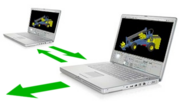Open collaborative design/Intro
A core element of this development model is a principle called 'copyleft'  (symbol:
(symbol: ![]() ) which is a way of applying copyright to a creative work in a way that makes sure that anyone can freely use it or build upon it - and also that derivative works inherit the same terms, ensuring anything based on the original is freely available too. This principle means that 'copylefted' items – whether they are designs, text, artwork or computer code – are effectively gifted to humanity, adding to an ever increasing universal 'commons'. Because this principle is to the benefit of everyone, it completely changes the way that many people think about contributing their time and effort to this type of project. It already works very effectively with many high profile, successful software projects, so this is not merely wishful thinking.
) which is a way of applying copyright to a creative work in a way that makes sure that anyone can freely use it or build upon it - and also that derivative works inherit the same terms, ensuring anything based on the original is freely available too. This principle means that 'copylefted' items – whether they are designs, text, artwork or computer code – are effectively gifted to humanity, adding to an ever increasing universal 'commons'. Because this principle is to the benefit of everyone, it completely changes the way that many people think about contributing their time and effort to this type of project. It already works very effectively with many high profile, successful software projects, so this is not merely wishful thinking.
Open collaborative design is a nascent field that has huge potential to radically alter the way we create goods, machines and systems – not only for personal items but all the way up to components of national or global infrastructure.
